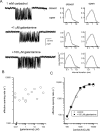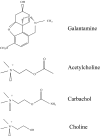Galantamine activates muscle-type nicotinic acetylcholine receptors without binding to the acetylcholine-binding site
- PMID: 15728839
- PMCID: PMC6726061
- DOI: 10.1523/JNEUROSCI.4985-04.2005
Galantamine activates muscle-type nicotinic acetylcholine receptors without binding to the acetylcholine-binding site
Abstract
Galantamine (Reminyl; Janssen Pharmaceutica, Titusville, NJ) belongs to a class of acetylcholinesterase inhibitors approved for symptomatic treatment of Alzheimer's disease. The drug presumably acts by raising and prolonging the profile of acetylcholine (ACh) via an inhibitory effect on the esterase. However, there is also evidence demonstrating that galantamine can activate the nicotinic ACh receptor or modulate its activation by ACh. In this study, we have examined the ability of galantamine to directly activate the muscle-type nicotinic ACh receptor or to modulate receptor activation by selected nicotinic agonists. Studies of direct activation by galantamine demonstrated that this ligand is a low-efficacy agonist of the muscle-type ACh receptor. Point mutations in the M2-M3 linker (alphaS269I) and the M2 transmembrane domain (epsilonT264P) had similar effects on receptor activation by galantamine and nicotinic agonists, suggesting that the general features of receptor activation by galantamine are similar to that in the presence of ACh. Experiments performed in the simultaneous presence of galantamine and various nicotinic ligands showed that channel activation by the nicotinic ligands studied (ACh, carbachol, and choline) was not affected by the presence of galantamine at concentrations up to 100 microm. In addition, galantamine did not reduce the initial rate of binding for 125I-alpha-bungarotoxin. These results demonstrate that galantamine does not interfere with the occupation of the nicotinic agonist binding site by ACh, carbachol, or choline. We conclude that galantamine activates the muscle-type ACh receptor by interacting with a binding site that is distinct from the site for nicotinic agonists.
Figures







References
Publication types
MeSH terms
Substances
Grants and funding
LinkOut - more resources
Full Text Sources
